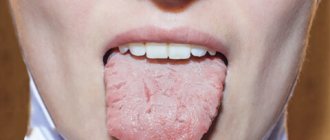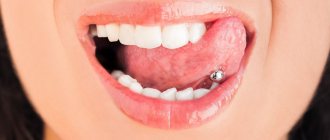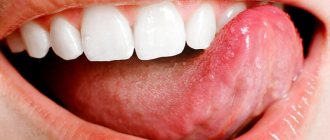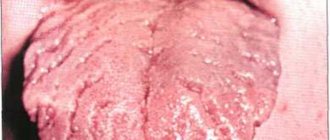December 29, 2019
Glossitis of the tongue is the most common inflammatory lesion of the tissues of the tongue, which can occur due to many different reasons. In all cases, treatment of the pathology is necessary, because it causes pain and discomfort and worsens the quality of life. In addition, it can be contagious, which is unsafe for others, and can develop into a cancerous tumor and even lead to death. So that you remember that the tongue is an important indicator of processes occurring in the body and can seek help in a timely manner, the editors of the UltraSmile.ru portal will tell you about all possible types of glossitis.
Surface type
In general, the disease can affect different areas of the mucous membrane, but the superficial variety affects only its upper layer. Superficial glossitis of the tongue can be seen in the photo.
The photo shows superficial glossitis of the tongue
It all starts small - the catarrhal stage of the disease. First, the mucous membrane becomes swollen, and upon visual inspection it is noticeable that it is covered with a dense coating. If treatment is not started during this period or the pathology is not completely cured, then an ulcerative form develops - small painful aphthae appear on the mucous membrane, which can bleed.
What is glossitis of the tongue? This is a disease that, like many other dental pathologies, can occur in acute and chronic stages. It can have pronounced symptoms or a sluggish inflammatory process that will go unnoticed for a long time, undermining your health. That is why it is so important to undergo timely preventive examinations with a dentist and therapist.
Deep type
Glossitis, as in the photo, affects the entire surface and thickness of the tongue. The photo shows that the disease has affected the root and frenulum.
In the deep form, the tongue is completely affected
It is characterized by the formation of ulcers, deterioration of the patient’s condition, and throbbing, sharp pain. The tongue swells, which makes speech difficult, and the process of chewing and swallowing food, as well as breathing, is disrupted. If treatment is not started, a person will develop an abscess or phlegmon, spreading to the surrounding tissues up to the cervical areas.
Desquamative
Glossitis on the tongue, as in the photo, is scientifically called desquamative, migratory or exfoliative1, but popularly this disease is better known as “geographic tongue”, because in appearance it resembles a geographical map with clearly defined continents in the form of bright red areas of the affected area. mucous membrane.
The photo shows the geographic language
The disease most often develops in the fair half of humanity, more often during pregnancy due to metabolic disorders, when the expectant mother lacks vitamins and useful nutritional minerals. Also, pathology often develops against the background of chronic lesions of the gastrointestinal tract, burns of the mucous membrane and acute allergic reactions.
It is worth knowing that this form rarely develops into an acute stage, so if characteristic signs appear, you should not wait for accompanying symptoms, such as pain or swelling - you should immediately consult a doctor.
Causes depending on the location of pain
Pediatric dentistry in St. Petersburg will understand every problem, find out the causes of the disease, and prescribe therapy. Provoking factors include:
- Organ damage in chronic and acute form. This could be inflammation or the negative effects of medications.
- Fungal and infectious diseases of internal organs, vitamin deficiency, dysbacteriosis.
- Poor hygiene, alcohol consumption, smoking.
- Glossitis is inflammation of the outer layers of the mucous membrane. The disease occurs due to impaired blood circulation in the capillaries. It is provoked by a burn, cut, or injury. The disease goes away quickly, as saliva disinfects the wounds.
- Streptococci, staphylococci, viruses act pathogenically.
Main forms of pathological processes:
- Galvanic stomatitis;
- Geographical language;
The first disease develops against the background of staples, braces, and occlusion. A white coating and spots with pimples appear. If the form of the disease is severe, burning, erosion, irritation, and tooth marks on the lateral planes occur.
Geographic tongue is a disease of mucous tissue of a dystrophic and inflammatory nature. Desquamations appear on the surface of the organ, that is, areas with scaly peeling. In such areas the epithelium becomes red. They are surrounded by a rim of white epithelium, which peels off. The disease appears against the background of improper tissue nutrition, gastrointestinal diseases, and during the eruption of incisors, fangs, and molars.
The tip of the tongue hurts
The tip of the muscular organ is rich in taste buds and nerve plexuses. The ducts of the salivary anterior glands exit into this area. Every component can be damaged. If the tip of the tongue hurts, you can assume:
- Damage from trauma;
- Negative influence of physical factors;
- Allergies;
- Development of inflammatory processes;
- Glossalgia;
A child can be injured by hasty eating or inept use of cutlery. An accidental bite may cause bleeding. Damage is caused by salty, spicy foods, low and high temperatures. In such cases, children complain of pain and numbness. With reduced immunity, inflammation often develops. The aphthous form of stomatitis, which is caused by pathogenic agents, is often diagnosed. The disease manifests itself as deep ulcers, at the bottom of which plaque with a white tint accumulates. They heal slowly. Children's temperature rises and they feel unwell.
Viral pathogens cause herpes disease. The mucous membranes of the oral cavity are covered with colorless bubbles. After opening, ulcers form in their place and bleed. The baby may develop a fever.
The frenulum under the tongue hurts
If your child has pain in the frenulum under the tongue, you need to see a doctor to find out the cause of the problem. The main provoking factors are:
- Initial period of stomatitis;
- Incorrectly chosen mouthwash, brush or paste;
- An hysterical cry the day before, active singing;
- Microtraumas;
- Inflammation that appears as a result of an allergic reaction or enlarged lymph nodes;
- Caries, an infection of the gum tissue;
Problems arise due to a short frenulum. Insufficient ligament length can be corrected with conservative therapy or trimming. Specific gymnastics helps recovery: rolling a muscle organ into a ball, folding it into a tube. Exercises help stretch the ligament. Surgery is performed at any age, preferably in preschool. It is optimal to operate the ligament in infancy, since newborn children easily tolerate such manipulations.
Pain at the base of the tongue
Inflammation of the gums in a child is an unpleasant disease. The baby becomes capricious, whiny, his temperature may rise, and his appetite disappears. The sooner the parents show the little one to the doctor, the easier and faster the therapy will be. Children often complain of pain in the root area of the speech organ. This can happen when:
- The area of the base of the tongue is injured: wounds, injections, cuts. Children often suffer from foreign objects entering the oral cavity. If the injuries are serious, they are treated in a hospital.
- A viral or bacterial infection enters the body. The surface of the tongue becomes covered with ulcers and blisters. They interfere with swallowing food and speech. The pathology covers the tonsils, pharynx, and larynx.
- The salivary glands become clogged, which interferes with the swallowing process.
- Medicines are used uncontrollably.
- Neuralgia, allergies, anemia develop, and hormonal disorders appear.
Chronic diseases can be associated with failure to comply with hygiene rules. In any case, parents need to show the child to a doctor for medical care.
Gunterovsky
Möller-Gunther glossitis is a form of the disease in which the patient has a visually smooth tongue. Main reasons: deficiency of folic acid and vitamin B12, anemia. The photo shows a characteristic picture of the pathology - the affected organ shines and looks like it is varnished. This occurs due to atrophy of the papillae of the tongue and thinning of the epithelial cover. When touching and mechanical impact there is a sharp pain.
It is interesting that the characteristic signs of this variety can appear long before the symptoms of the underlying disease (in particular, anemia) leading to glossitis are identified.
With this pathology, the tongue shines
“One morning I woke up, as if nothing had happened, went to brush my teeth and, opening my mouth, was stunned - my tongue was crimson and shiny, slightly swollen. It felt like it had been rubbed with sandpaper for a long time, and then covered with a layer of transparent varnish. Horror! There was no pain or other signs. I waited a few days, nothing changed, in principle, I immediately started reading what it could be. Then I went to see a therapist. After the examination, a diagnosis was made - “Gunther-Möller glossitis” and, it seems, “tongue atrophy”. In principle, the treatment was quite simple, but it is not known what would have happened if I had not been such an alarmist and had not immediately gone to specialists...”
Olga, review from woman.ru
Diamond tongue
The lesion is localized on the back of the organ; the tissues in this area, due to thickening of the epithelium, acquire a clearly defined oval or diamond-shaped shape. Diamond-shaped glossitis of the tongue, as in the photo, occurs chronically, but with periods of exacerbation. Often recurs. If treatment is not carried out, then neoplasms appear on the affected tissues, similar in appearance to papillomas or warts, covered with keratinized epithelium. May develop into a malignant tumor.
This is what rhomboid glossitis looks like
Diamond-shaped (median) glossitis
Most often, rhomboid glossitis is a congenital anomaly of the tongue as a result of disruption of fetal development processes. But it can also occur against the background of chronic diseases of the digestive system, especially with low acidity of gastric juice.
This form of glossitis is characterized by thickening of the epithelium and the appearance of a diamond-shaped lesion on the posterior third of the tongue in front of the circumvallate papillae along the midline of the tongue. The color of the affected area may be bluish-red. Rhomboid glossitis is a chronic disease and can torment a person for years with multiple relapses.
There are 3 forms of rhomboid glossitis:
- flat (smooth: the surface of the lesion is smooth, polished, there are no papillae of the tongue)
- warty (tubercular: the presence of lumpy dense outgrowths)
- papillomatous (hyperplastic: the presence of whitish-pink growths with a wide base and flattened apexes).
Treatment for rhomboid glossitis depends on its shape. For flat glossitis, treatment is usually not carried out. Warty and papillomatous glossitis are subject to surgical treatment. In this case, laser evaporation and tissue hair removal, as well as radiosurgery, are most often used.
Folded shape
The name speaks for itself. This form of glossitis has the following visual symptoms: folds, grooves, the presence of longitudinal and transverse lines. It is interesting that most patients seek help and undergo treatment only because of complaints of a visual defect and an unusual appearance of the tongue, because The pathology practically does not manifest itself with other signs.
The photo shows a folded tongue
Despite the absence of pain and discomfort, the folded form of the disease must be treated, because grooves and folds are an excellent place for the accumulation of pathogenic bacteria and tiny food particles, and thorough hygiene of these areas is almost impossible. Due to lack of treatment, the patient may develop serious inflammatory processes in the oral cavity and abscesses, the removal of which will require surgery and long-term drug therapy.
Be sure to read the whole truth about the folded tongue and the reasons for its appearance in the feature article on the website.
Hairy black tongue
Such inflammation of the tongue, as in the photo, is a consequence of the proliferation and keratinization of the papillae. The main provocateurs for the development of the disease are mechanical and chemical damage, long-term use of antibiotics, and untreated oral candidiasis. The patient with this pathology does not experience the most pleasant sensations. Firstly, filiform papillae on the mucosa can grow up to 1-2 cm in height. Secondly, the affected areas become black, which looks aesthetically unattractive and forces you to always keep your mouth shut. Plus, physical discomfort also manifests itself: most often, patients complain of vomiting and a sore throat.
The photo shows hairy black glossitis
Why does my tongue hurt?
Physiological reasons
Pain in the tongue is often the result of minor injuries: superficial burns from too hot liquid, accidental biting, damage from hard pieces of food, fish bones.
Painful sensations are combined with numbness or, on the contrary, hypersensitivity. They disappear within a few minutes or hours, less often – days. Burning and sore tongue can also be caused by eating spicy foods, certain spices, or drinking strong alcoholic beverages. In people who smoke, the sensitivity of the tongue increases due to the constant effect of tobacco smoke on the mucous membrane, which leads to the frequent occurrence of pain under the influence of other irritants.
Traumatic injuries
More serious injuries occur due to biting the tongue during an attack of epilepsy, sports, or accidents. Abrasions and wounds in the form of teeth marks are found on the tongue. Depending on the severity of the damage, pain lasts from several days to 1-2 weeks. In patients with incorrectly selected orthodontic structures or poorly fitted removable dentures, pain becomes the result of chronic irritation of the tongue. With advanced caries, the organ is systematically injured by the sharp edges of the teeth.
Glossitis
Pain syndrome is not observed with all glossitis; it is more typical for infectious lesions. The inflammatory process of bacterial etiology is manifested by hyperemia, swelling, increased local temperature, aching, raw pain. With viral glossitis, blisters form, which subsequently open to form painful erosive defects.
Tongue pain
Abscess and phlegmon of the tongue
An abscess develops against the background of microtrauma or becomes a complication of bacterial glossitis. Characterized by rapid onset and progression of symptoms. Superficial abscesses are localized under the mucosa, usually in the back area. They represent an area of limited swelling with a painful thickening in the center. They are accompanied by sharp pain when moving the tongue, swallowing, and sometimes radiating into the ear.
Deep abscesses are located deep within the organ. They manifest themselves as hyperthermia, intoxication syndrome, in some cases – chills, enlarged regional lymph nodes, and excessive salivation. The tongue is so swollen that it can hardly fit in the mouth, making speech and breathing difficult. The pain is sharp, jerking, bursting, pulsating, aggravated by movement, swallowing, or touching.
In patients with phlegmon, the area of purulent inflammation is not limited, quickly spreading to the entire tongue, floor of the mouth, and neck. Febrile fever, chills, and regional lymphadenitis are observed. The pain syndrome is intense, diffuse, depriving sleep. Eating is very difficult or impossible. Speech is slurred. Due to the blockage of the airways due to swelling of the soft tissues of the oral cavity and oropharynx, attacks of suffocation develop.
Oral candidiasis
Painful sensations are more often observed in acute candidiasis, but are not typical for the chronic form of the disease. Children, old people, and weakened patients with severe somatic pathologies suffer. A loose or dense milky-white cheesy coating forms on the tongue, spreading to the palate, cheeks, and lips. When plaque is removed, a bleeding, eroded or macerated mucous membrane is exposed.
When eating food, pain and burning occur. In the absence of therapeutic measures, transformation into atrophic candidiasis is possible. The tongue becomes shiny, fiery red. The papillae atrophy. The mucous membrane of the oral cavity is swollen, hyperemic, dry, thinned. Patients complain of severe pain in the affected area. Plaque is not detected or is insignificant.
Glossalgia
Glossalgia is a pathology accompanied by unpleasant sensations in the tongue in the absence of organic changes. Occurs in diseases of the liver and gastrointestinal tract, vascular, endocrine diseases, pathologies of the central and peripheral nervous system. Painful sensations without clear localization, diffuse, have a burning, pinching or sore character, are more pronounced in the area of the tip and sides, less often appear on the root and back of the tongue. May be episodic or regular. As a rule, they are combined with neurotic disorders.
Xerostomia
Pain in the tongue is a concern in the final stages of the disease. Against the background of complete inhibition of the function of the salivary glands, glossitis develops. Constant dryness of the mucous membrane leads to the formation of erosions and ulcers. Painful sensations intensify when talking, while eating, and are combined with constant dry mouth. Patients with xerostomia may have multiple caries.
Neuralgia
Pain in the two anterior thirds of the tongue is characteristic of damage to the third branch of the trigeminal nerve (n.mandibularis), combined with painful sensations in the chin, lower jaw, lower lip, gums, and buccal mucosa. The pain syndrome is paroxysmal in nature and is a series of impulses resembling an electric shock. It is provoked by cold influences, shaving, chewing, speech, laughter.
With neuralgia of the glossopharyngeal nerve, pain appears at the root of the tongue, from where it spreads to the tonsils, soft palate, pharynx, and sometimes to the ear, eye, and lower jaw. The attack is provoked by swallowing, chewing, yawning, coughing, talking, and is accompanied by dryness in the throat, which at the end of the paroxysm is replaced by increased salivation.
Neuralgia of the hypoglossal ganglion is characterized by pain in the anterior parts of the tongue, the sublingual zone: boring, burning, pulsating, paroxysmal. Lasts from a few minutes to 1 hour. It radiates to the lower jaw, temple, back of the head, side of the neck, shoulder girdle, sometimes to the arm, upper chest. It intensifies when talking, eating, especially rich or spicy food.
Anemia
Pain in the tongue is typical of pernicious anemia and is caused by glossitis. The tongue becomes “varnished” and acquires a crimson color. Weakness, tachycardia, and dizziness are observed. Characteristic symptoms are shortness of breath, pale skin, puffiness of the face. Loss of appetite, hepatomegaly, and stool instability are detected. Neurological disorders are detected: muscle weakness, gait changes, stiffness, numbness of the limbs.
Sometimes painful sensations in the tongue area occur with iron deficiency anemia. Glossitis is combined with dysphagia, angular stomatitis, and atrophic gastritis. The prevailing symptoms are weakness, tinnitus, dizziness, shortness of breath, and palpitations. Dry skin, deformed nails, and hair loss are noted.
Other reasons
Pain in the tongue is sometimes detected in the following conditions:
- Allergy
. Soreness, paresthesia, severe itching are caused by food allergies, less often - by a reaction to plant pollen or animal fur. Combined with sneezing, lacrimation, swelling of the mucous membranes. - Initial stages of cervical osteochondrosis.
Vague pain sensations in the tongue are complemented by awkwardness, restrictions in neck movements, and pain in the neck. - IHD.
Pain in the tongue, oral cavity, and lower jaw can be observed during an atypical course of an attack of angina pectoris or myocardial infarction.
Oral examination
Atrophic or pellagritic form
With this pathology, the inflamed tongue, as in the photo, does not significantly change its natural color, but it becomes very smooth, which is why it is easily confused with the Gunter variety. However, here the atrophy of the papillae is more pronounced; if left untreated, they decrease and may even completely disappear from the mucous membrane. In rare cases, a decrease in the muscle organ itself occurs.
The atrophic form is characterized by smoothness of the tongue
The disease is caused by an acute lack of vitamins in the body, as well as a lack of nicotinic acid.
Hairy black tongue (villous glossitis)
This form of glossitis is characterized by the growth and keratinization of filiform papillae (they become hair-like). The mechanism of development of this disease is not fully understood. According to one version, the development of villous glossitis is facilitated by the influence of local irritating factors, as well as candidiasis that develops while taking antibiotics.
Treatment of this form of glossitis includes mechanical (tweezers) removal of filiform papillae and subsequent treatment of the surface of the tongue with a solution of copper sulfate. For candidiasis, antifungal agents are prescribed.
Interstitial or sclerosing
Glossitis, shown in this photo, occurs in adults due to the presence of such a serious disease as syphilis. Symptoms: the affected muscles are gradually replaced by fibrous connective scar tissue, the papillae are completely smoothed out, painful cracks and trophic ulcers appear. The organ acquires tuberosity, because foci of inflammation grow unevenly. Externally it resembles a quilted blanket. The patient's tongue movement is difficult, swallowing and chewing functions are impaired, and speech is altered. And if treatment is not carried out in a timely manner, then there is a risk of oncological progression of the disease in areas of inflammation.
Candidiasis glossitis occurs with syphilis
Candidamycotic, or yeast
The inflammation on the tongue shown in the following photo is caused by yeast-like fungi of the genus Candida. In this case, the entire mucous membrane of the muscular organ is covered with a dense gray coating, hyperemia and swelling are also noted, and the sick person experiences a painful burning and itching, and it is painful for him to eat and chew food. Severe dry mouth is also noted.
The photo shows candidiasis glossitis
Read the article on the topic: 7 colors of plaque on the tongue - how not to miss a dangerous disease.
As you can see, there are a lot of forms of glossitis; there are also herpetic, ulcerative, phlegmonous, and leprosy. Each has symptoms that differentiate it from other types, and each requires immediate treatment. However, in order for the treatment to be correct, it is necessary to understand what exact reason served as the starting impetus for the development of the disease.
Symptoms of glossitis
The symptoms of glossitis are varied. They depend on what exactly caused the inflammation. An examination of the oral cavity by a dentist allows the doctor to suspect the etiological factor of glossitis, focusing on its signs.
However, there are general symptoms that characterize inflammation of the tongue in general:
- A coating forms on the surface of the tongue, and spots may form.
- Glossitis is often combined with ulcerative stomatitis.
- The color of the tongue changes. Moreover, it can become a different color both over the entire surface and partially.
- The tongue swells. Sometimes the swelling is very intense.
- Often the mobility of the tongue is limited.
- There will be an unpleasant odor coming from your mouth. This phenomenon is called halitosis. Bad breath indicates bacterial growth.
Often the symptoms of glossitis are combined with a deterioration in taste. Patients complain of burning and rawness in the mouth. All unpleasant symptoms intensify when eating food and when trying to move the tongue.
The patient's general well-being is not affected. If this happens, then serious diseases of the internal organs can be suspected.
The main reasons for the development of pathologies
Many people ask questions about how and how to treat glossitis of the tongue. But, as we noted above, before prescribing a set of therapeutic measures, you first need to find out what form of pathology the patient has and what exact reason it is caused by.
| Oral problems | Diseases of the body | Related factors |
|
|
|
Do you think you have glossitis of the tongue and don’t know what to do? Even minor symptoms of pathology and slight discomfort are a reason to consult a doctor who will conduct a comprehensive examination (examination, smear or scraping, blood tests and LBC culture, histology), make an accurate diagnosis and prescribe treatment.
Features of glossitis in children
Glossitis in childhood is often a consequence of problems with bite. Other causes include: viral and bacterial infections, helminthic infestations, diabetes mellitus, genetic abnormalities. Often inflammation manifests itself due to the consumption of hot food or too cold drinks, as well as when dirt gets into the mouth.
Often children under 3 years of age suffer from herpetic stomatitis. If you consult a dentist in time, you will be able to cope with the inflammation quickly.
The main causes of glossitis in children are:
- Poor quality oral care.
- Tongue injuries that children receive due to falls.
- Allergy to dental fillings.
- Poorly installed fillings.
- Pathological inflammation of braces, plates or other structures designed to correct the bite.
- Frequent tongue biting by a child.
- Tongue injury from hot or cold foods. In this case, the likelihood of infection increases, which will further provoke an inflammatory response in the body.
- Infection with worms or other parasites.
- Diabetes mellitus in childhood often leads to candidal glossitis. Fungal glossitis can be triggered by taking antibiotics.
- Decreased immunity in a child.
Diseases that can cause glossitis in childhood:
- Diabetes.
- Atopic dermatitis.
- Pathologies of the endocrine system.
- Any infections.
- Blood diseases.
- Diseases of the digestive system.
Sometimes children do not complain about inflammation of the tongue. Therefore, parents should regularly examine the child's oral cavity. Although in some cases children show some anxiety, become capricious, and indicate pain in the mouth.
Catarrhal glossitis can develop during teething, after an injury. Bacterial inflammation often results from diseases of internal organs. Atypical dermatitis and pathologies of the digestive organs lead to desquamative glossitis.
How is the treatment carried out?
The main treatment will be aimed at eliminating the disease or pathology that entails consequences in the form of glossitis. The patient will also be prescribed antiseptic treatment of the oral cavity (for example, “Chlorhexidine”), anti-inflammatory therapy, wound-healing and cell-regenerating ointment (Solcoseryl, vitamin A, rosehip oil), vitamins, anesthetic drugs and applications. The keratinized areas of the affected tissue are removed through surgery. If abscesses and ulcers are present, they are opened and drained. For fungal infections, antibiotics are prescribed.
"Chlorophyllipt" is prescribed for treating the oral cavity
During treatment, it is also necessary to follow a gentle diet, excluding hard, spicy, salty, sour and hot foods, which can injure the mucous membrane and cause additional discomfort.
Is glossitis contagious?
It comes as a surprise to many people that the disease can actually be contagious. Here you need to understand that if glossitis of the tongue occurs due to non-infectious causes, for example, mechanical injuries and burns, then it is not contagious. If the cause of its development is infections, viruses and bacteria, for example, staphylococcus, streptococcus, herpes virus or candida fungi, then the pathology can become dangerous not only for you, but also for others and family members.
In addition, glossitis on the tongue may indicate that you have problems in the body, which again can be contagious to outsiders: diphtheria, helminthic infestations, tonsillitis, scarlet fever, syphilis.
Notice
: Undefined variable: post_id in
/home/c/ch75405/public_html/wp-content/themes/UltraSmile/single-item.php
on line
45 Notice
: Undefined variable: full in
/home/c/ch75405/public_html/wp-content /themes/UltraSmile/single-item.php
on line
46
Rate this article:
( 10 ratings, average: 4.90 out of 5)
language
- E.V. Borovsky, A.L., Mashkilleyson M. Diseases of the mucous membrane of the oral cavity and lips, 1984.
Consulting specialist
Dzagurova Elina Ruslanovna
Doctor rating: 9.5 out of 10 (2) Specialization: Dentist-therapist Experience: 10 years
Causes of pimples in the mouth
70% of red, white or pinkish rashes in the oral cavity, including on the tongue, indicate the presence of a serious dental disease. The asymptomatic course of the disease does not mean that the “trouble” will go away on its own. However, prescribing treatment on your own, guided by the advice of friends or recommendations from the Internet, is dangerous.
Important!
In principle, there cannot be acne on the tongue. Purulent skin rashes develop due to inflammation of the sebaceous glands, which are not present in the mouth. Accordingly, we call those pimples that appear in the oral cavity “pimples” by analogy. Just by external similarity.
There are several reasons for the appearance of irritations that visually resemble pimples:
- mechanical damage. A prick with a fish bone, a scratch, a burn from hot coffee can provoke a similar pathology;
- allergy. Not necessarily to foods; a seasonal allergic reaction is possible, manifesting itself in such an unusual way;
- viral and infectious diseases. Herpes, rubella, scarlet fever and ARVI sometimes manifest themselves as rashes in the mouth;
- fungal infection (candidiasis);
- stomatitis. Usually, with stomatitis, pimples first appear on the gums, but sometimes red spots with a whitish halo, which react sharply to touch or spicy/hot food, form over the entire lingual surface.
There is no point in waiting until diseases become chronic. In 98% of cases, such pathologies are treated quickly and inexpensively, if you do not neglect the condition and do not self-medicate.
Comments
I looked at various photos about glossitis of the tongue in your article and was horrified. Tell me, I am interested in this question: is it possible to treat this disease with folk remedies?
Reveeva Sveta (12/31/2019 at 11:43 am) Reply to comment
- Dear Svetlana, it is recommended to use traditional medicine methods only as an additional measure to the main treatment and only in consultation with a doctor. Decoctions of sage, chamomile, and oak bark effectively eliminate inflammatory processes. Soda-saline solution disinfects, tea tree oil and sea buckthorn oil heal the mucous membrane.
Editorial staff of the portal UltraSmile.ru (01/05/2020 at 09:15) Reply to comment
What happens if glossitis is not treated? The older sister seems to have it, but she doesn’t want to go to the doctor to get examined.
Marina (16.01.2020 at 18:22) Reply to comment
- Dear Marina, it is important to start treatment of the pathology in a timely manner, then the outcome is almost always positive. But if this is not done, the disease may be complicated by the formation of an abscess or phlegmon (which can spread to the neck, jaw or face). Purulent inflammations, in turn, are fraught with the development of sepsis, i.e. blood poisoning, which in extreme cases can be fatal.
Editorial staff of the portal UltraSmile.ru (01/22/2020 at 09:36) Reply to comment
Which doctors should you contact about geographic tongue? Can it appear on the sides of the tongue?
Daria (04/25/2021 at 00:12) Reply to comment











